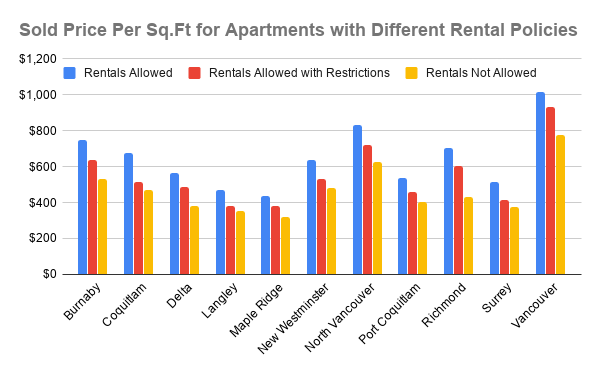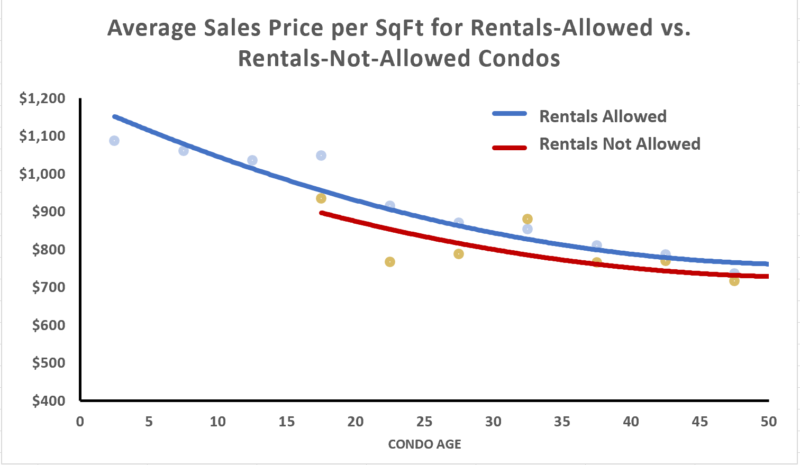The question of whether or not rental restrictions in strata buildings should be banned has been hotly debated in recent years. Banning all restrictions on rentals units would instantly create an inventory of available homes, as currently empty homes could now be rented out. Vancouver’s housing crisis being largely an issue of supply, this additional inventory would be warmly welcomed.
Strata buildings are usually categorized in one of three ways: rentals allowed, rentals allowed with restrictions, and rentals not allowed. A recent report by Roomvu Marketing—a Vancouver real estate data analytics company—evaluated the effect of rental policies in different buildings across eleven different municipalities in the Lower Mainland. Data from apartments sold between 2017-2019 were examined to calculate the median sale price per square foot.

The data showed that buildings not allowing rentals sold at notably lower prices when compared to those that allowed rentals or allowed rentals with restrictions. The report also mentions that the majority of apartments studied allowed rentals or allowed rentals with restrictions (58% and 31 percent respectively), whereas only 11 percent disallowed rentals completely.

The data scientists at Roomvu delved deeper into the price gap between apartments based on rental restrictions. It quickly became apparent that rental policy alone wasn’t the only, or even the main, contributing factor in the price per square foot—the age of the building had much to do with it.
They found that the average age of buildings that allowed rentals were 11 years old, those that allowed rentals with restrictions were 21 years old, and those that didn’t allow rentals at all were 31 years old.
The team then went about teasing out the different impacts age and rental policies had on prices per square foot. They compared Vancouver buildings allowing rentals and allowing rentals with some restrictions against those that did not, while considering the age of the building.

The comparison showed that although there are many variations among the prices in each age range, in general, buildings where rentals were allowed sold at slightly higher prices almost in all range of ages. Also, the number of buildings younger than 15 years old which follows the rentals-not-allowed policy was not enough to get a precise judgment in prices. It is not easy to say how much cheaper the rentals-not-allowed units are compared to the rentals-allowed since too many factors such as age, floor area, neighbourhood, etc. can affect the price, but one could expect to pay roughly $30,000 less if the building follows the rentals-not-allowed regulation. Apartments ranging from 15 to 50 years old are considered for this calculation.
While not ubiquitously accepted, it’s fair to say that Vancouver is becoming a rental-friendly city. Much of the housing affordability crisis has created the effect of homeownership becoming an ambitious if not unrealistic dream. As such, the reality for many in Metro Vancouver is one where renting one’s home is the only option—and might always be so.
What the data in the report shows is that the vast majority of apartment buildings in the region allow rentals—even if around one-third place restrictions on rentals. If you’re a homeowner, this is at best good for the community, and at worst, benign to your existence. If you’re someone who depends on renting as a way of life, this is great news. And at worst, it’s an encouraging step in the right direction.
